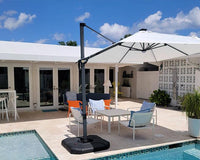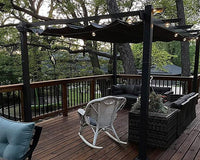The sun shines, your beverage is warming, and all at once, your beautiful patio becomes more like a furnace. A patio umbrella looks like the perfect answer, something that happens to adorn so many backyards. Yet beyond the momentary grace of shade, is it an investment that really delivers in terms of comfort, usability, and worth? Let's find out.
4 Key Advantages of Owning a Patio Umbrella
1. Creates Essential Shade and Comfort
The greatest benefit, naturally, is shade creation. This alone makes your outdoor dining area more bearable on bright, hot days, allowing you to utilize your patio for longer. Harsh direct sunlight can be unwelcome, and a good umbrella offers relief from it, cooling the surrounding air within its shaded zone.
2. Provides Crucial UV Protection
Beyond comfort, UV protection is a significant health advantage. Quality umbrella canopies are designed to block a high percentage of harmful ultraviolet rays, safeguarding your skin and eyes during those leisurely outdoor afternoons. This is especially important for families with children or anyone sensitive to sun exposure.
3. Extends Furniture Lifespan
A well-chosen umbrella can also protect your outdoor furniture. Constant exposure to direct sunlight can cause patio chairs, tables, and cushions to fade, crack, or deteriorate prematurely. An umbrella acts as a shield, prolonging the life and appearance of your other outdoor investments.
4. Enhances Outdoor Aesthetics
From an aesthetic standpoint, a patio umbrella can define an outdoor space. It can act as a visual anchor for a seating or dining area, adding a pop of color or a touch of elegance. It helps create a more inviting and "room-like" feel to your patio or deck.

5. Offers Light Rain Protection
Finally, in many climates, an umbrella can offer light rain protection. While not designed for downpours, it can certainly allow you to continue enjoying a meal or conversation outdoors during a passing light shower, adding to the versatility of your space.
Potential Downsides and Considerations
The most significant drawback for many patio umbrellas is their vulnerability to wind. A sudden gust can turn an unsecured or poorly designed umbrella into a projectile, potentially causing damage to property or even injury. This means they often need to be closed and secured when not in use or if the wind picks up. Fortunately, there are several effective methods to anchor your umbrella properly and prevent wind-related accidents, from weighted bases to specialized securing techniques that can keep your outdoor shade solution safely in place even on breezy days.
Space and storage would also be an issue. Though closed, a big umbrella does take up space. On smaller patios, the base size and closed umbrella itself are a hassle. Storage during the off-season also needs to be considered, since exposed to harsh winter conditions will shorten its life.
Maintenance is unavoidable. Canopies accumulate dirt from pollen, bird droppings, and general outdoor dirt and therefore must be cleaned every so often. The frame and mechanisms can also need the occasional check-up and lubrication to ensure they move properly.
Its cost is rather fluctuating. While there is always an inexpensive choice, a sturdy, good-quality umbrella with proper UV protection and strong frame is a higher initial investment. The inexpensive ones might not last very long, leading to replacement earlier than you would like.
Lastly, a poorly chosen or low-quality umbrella can detract from your patio's aesthetic. A faded, torn, or wobbly umbrella looks unkempt and can cheapen the overall appearance of your carefully curated outdoor space.
What Separates a Good Umbrella from a Bad One?
Understanding the components will help you invest wisely.
- Frame Material: Aluminum is a popular choice as it's lightweight, strong, and rust-resistant. Look for powder-coated finishes for extra durability. Steel frames are heavier and very strong, but can rust if the finish is compromised. Wood frames offer a classic aesthetic but require more maintenance to prevent rot or weathering.
- Canopy Fabric: This is crucial for longevity and protection. Solution-dyed acrylics (like Sunbrella) are top-tier, offering excellent fade resistance, UV protection, and water repellency. Polyester is a common mid-range option, often treated for UV resistance, but may fade faster than acrylic. Olefin is another durable synthetic with good stain and fade resistance. Check the UPF (Ultraviolet Protection Factor) rating – higher is better.
- Operating Mechanism: Crank lifts are common and easy to use. Pulley systems are simpler but might require more effort. Tilt mechanisms (push-button, collar tilt, or auto-tilt) allow you to angle the canopy as the sun moves, which is a highly desirable feature.
- Base Stability: This cannot be overstated. The base must be heavy enough to secure the umbrella against moderate winds. For freestanding umbrellas, this is especially critical. Bases can be filled with sand or water, or come as solid weighted units. Heavier is generally better.
Types of Patio Umbrellas: Choosing Your Style
There are two main styles to consider for your patio:

- Center-Pole Umbrellas (Market Umbrellas): Market umbrellas are the traditional design, with a straight pole that fits through a hole in a patio table or stands alone in a weighted base. They are great for shading dining sets. Their stability often relies on both the table and a sturdy base.
- Cantilever (Offset) Umbrellas: Cantilever umbrellas have a robust, arched, or jointed pole positioned to the side, with the canopy suspended over the desired area. This design is excellent for shading lounge areas, conversation sets, or even hot tubs without a central pole getting in the way. They require a very heavy base due to their offset design and are generally more expensive.

How to Get the Patio Umbrella Dimensions Right
The size of your umbrella should correspond to the area you want to shade. A general rule is that the umbrella canopy should extend at least two feet beyond your patio table or seating group on all sides. For a 4-foot round table, an 8-foot diameter umbrella would be suitable. For larger rectangular tables or lounge areas, rectangular or larger round/square umbrellas are more effective. Measure your space carefully before you buy.
Essential Patio Umbrella Care and Maintenance
To maximize the lifespan of your patio umbrella, a little care goes a long way. Always close the umbrella when not in use, especially if strong winds or storms are forecast. Clean the canopy periodically with mild soap and water, and allow it to dry thoroughly before closing to prevent mildew.
During the off-season, if possible, store your umbrella in a dry, covered place. If outdoor storage is necessary, use a protective umbrella cover. Inspect the frame and moving parts occasionally for any signs of wear or looseness.
A Worthy Investment Under the Right Conditions
Is a patio umbrella worth the money? Yes, absolutely, if you choose wisely and treat it well. It brings comfort, sun protection from UV, extends the usage of your outdoor area, and can even improve appearance. The secret is to invest in quality materials, the right size and type for yourself, and a heavy base. A cheap, lightweight umbrella might provide a temporary reprieve, but it will become a maddening frustration.
Consider your weather, how you use your patio, and your budget. The properly chosen, durable patio umbrella can provide you with years of comfortable shade, really making your outdoor living area more inviting and functional.




